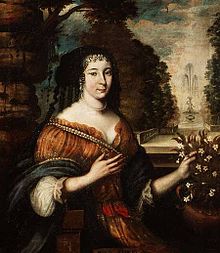Madeleine de Scudéry

Madeleine de Scudéry
|
|
| Born |
15 November 1607 Le Havre, Normandy |
| Died | 2 June 1701 (aged 93) |
| Language | French |
| Nationality | France |
| Genre | Novels |
Madeleine de Scudéry (15 November 1607 – 2 June 1701), often known simply as Mademoiselle de Scudéry, was a French writer. She was the younger sister of author Georges de Scudéry.
Born at Le Havre, Normandy, in northern France, she is said to have been very plain as well as without fortune, but she was exceedingly well-educated. Her father, captain of the port in Le Havre, died in 1613 with her mother following shortly after. Madeleine and her brother Georges de Scudéry were placed in the care of an uncle who cared for them very well. He gave Madeleine an abnormally well-rounded education: she studied writing, spelling, drawing, dancing, painting, and needlework. In addition, on her own, Madeleine studied agriculture, medicine, cooking, Spanish, and Italian. Her works also demonstrate comprehensive knowledge of ancient history that it is suspected she had received instruction in Greek and Latin. In 1637, following the death of her uncle, Scudéry established herself at Paris with her brother. Georges de Scudéry became a playwright. Madeleine often used her brother's name to publish her works. She was at once admitted to the Hôtel de Rambouillet coterie, and afterwards established a salon of her own under the title of the Société du samedi (Saturday Society). For the last half of the 17th century, under the pseudonym of Sapho or her own name, she was acknowledged as the first of France and of the world. She formed a close friendship with Paul Pellisson which was only ended by his death in 1693. She never married.
Her lengthy novels, such as Artamène, ou le Grand Cyrus (10 vols., 1648–53), Clélie (10 vols., 1654–61), Ibrahim, ou l'illustre Bassa (4 vols., 1641), Almahide, ou l'esclave reine (8 vols., 1661-3) were the delight of Europe, commended by other literary figures such as Madame de Sévigné. Artamène, which contains about 2.1 million words, ranks as the longest novel ever published. Her novels derive their length from endless conversations and, as far as incidents go, successive abductions of the heroines, conceived and told decorously. Contemporary readers also enjoyed these novels because they gave a glimpse into the life of important society figures. These figures were often disguised as Persian, Greek, and Roman warriors and maidens. In fact, Scudéry created the roman à clef to provide a forum for her thinly veiled fiction featuring political and public figures.
...
Wikipedia
